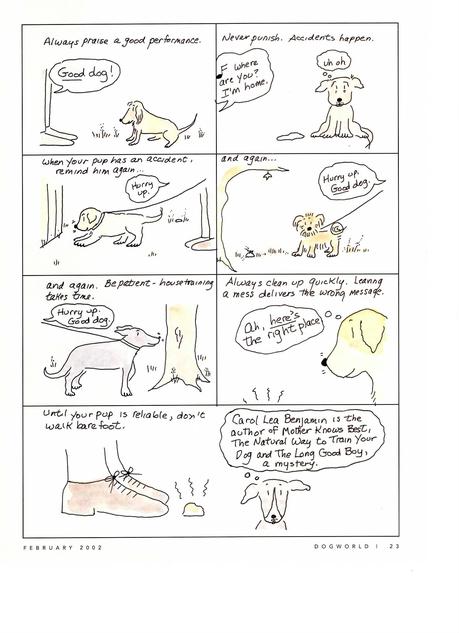
It’s critical that your dog understands his place in the household and behaves properly. For instance, you should be able to greet guests at the door without your dog rushing to get there first or refusing to let them in.
(Check out Top Six Dog Housetraining Rules)
There are a number of things you can do implement house rules that your pet understands. When you return home at any time of day, do what you need to do first, like taking of your coat and hanging it up or putting the groceries away. Do anything at all except go straight to your dog and give him attention. While he is rushing around in excitement at your return and demanding attention, ignore him.
You don’t want to reinforce his notion that he has high status in the household. After a while your dog will get fed up with being ignored and will either find something to do or lie down. AT this point, call him and give him a few minutes of attention.
Rules and Limitations
You have to have the respect of your dog since he lives in your home. Nothing’s more unpleasant than an unruly, unmanageable dog. Here is a list of rules and limitations that must be implemented in a household with dog/s.
- Humans are higher than the dogs in the hierarchy.
- If there’s more than one dog, let them work out their pack order and respect it.
- Write the rules down and post them on the refrigerator.
- Everyone in the household must follow the rules.
- Don’t let the dogs run through the house or hop on the furniture. They can hurt themselves or unintentionally hurt a family member.
- Don’t let a dog jump on anyone.
- No growling, barking, or snarling at family members or guests.
- A dog is an animal and not your child. They need their humans to treat them like dogs so they don’t get confused.
- Plan a dog’s every day timetable. Include daily exercise like a walk on a leash around the neighborhood.
- Socializing is vital. The dog must learn to behave properly around other dogs, people and kids on skateboards.
- Have a list of commands a dog needs to adhere to: sit, stay, come, and heel, down, leave it, and so on. Make sure each member of the family is aware of these commands and uses them. Use the hand signals that go with the commands.
- Give a task to each family member. Someone has to walk the dog daily. Another has to keep the dog’s water bowl full.
- Don’t disregard your dog’s bratty behavior; he must follow the rules and can’t boss around family members.

Every dog owner dreams of parenting the best dog there is – a puppy that’s easy and fun to train, a dog that’s well-behaved and loyal, and a senior canine that has been and continues to be a good canine citizen. *
The following are some straightforward rules you can do to keep control and have a well-mannered dog.
- When your dog is a puppy keep him on a leash whenever he’s out of his crate. This way you can correct any bad behaviors instantaneously.
- Limit his indoor space. Kiddie gates are helpful.
- If you adopt an older dog, keep him on a leash for the first month.
- When your dog is on leash don’t let him wander off by himself.
- Don’t let your dog run up and down the stairs, he could hurt himself.
- Teach your pet the sit/stay command right away.
- Teach your dog to go to his bed, do a down/stay and not leave his bed until you say so.
- Crate train your dog and have him sleep in his crate at night.
- Go out the door first. This straightforward rule conveys to your dog you’re in charge.
- Don’t let your dog become aggressive with anyone.
- Build a dominance position with your dog. That means YOU are the pack leader.
- Don’t shout at or hit your dog.
- Discover ways to redirect your dog’s bad behaviors into good behaviors.
- Always leave a training session on a good note. Canines remember how the program ended.
* image source

